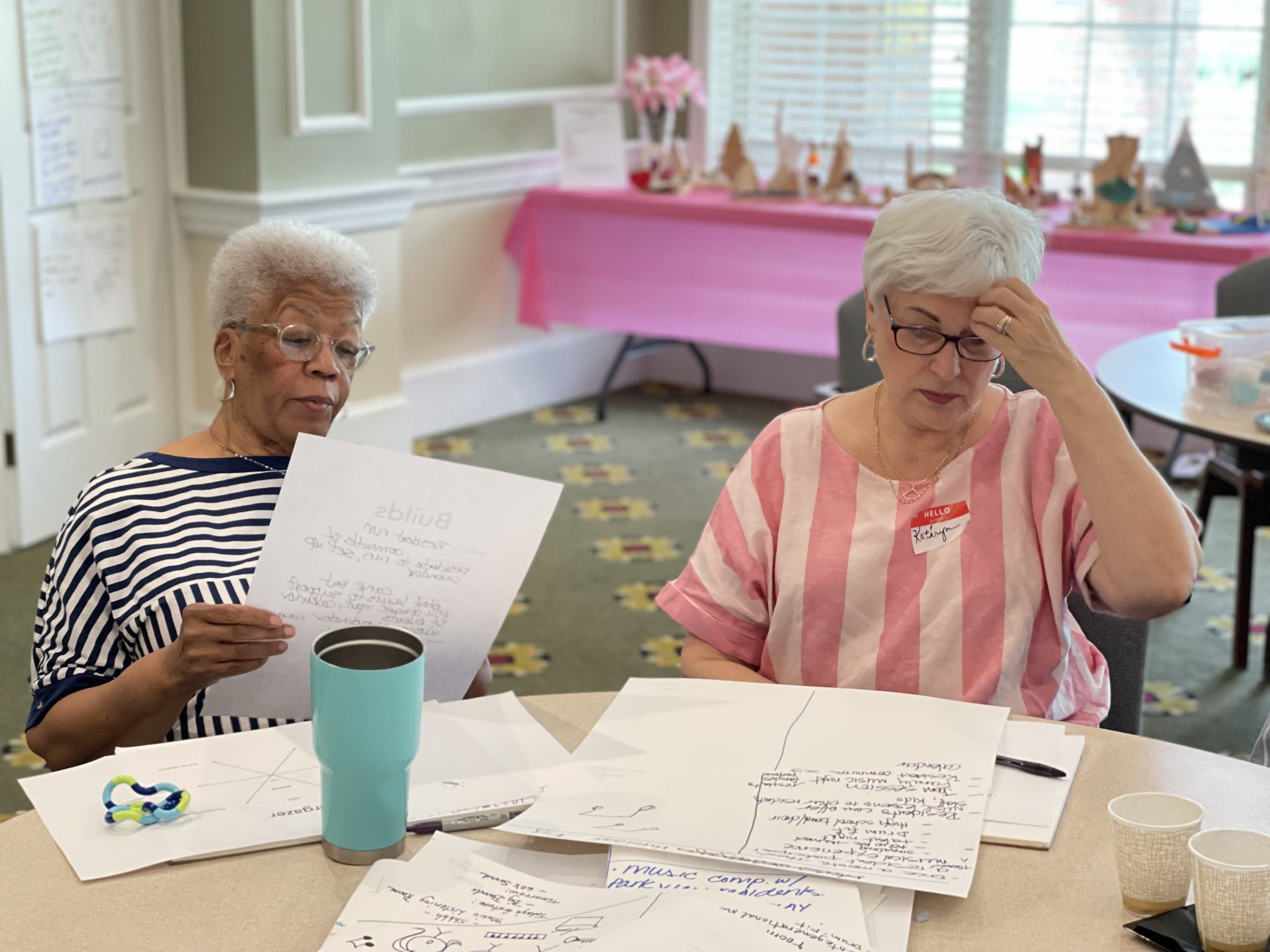Experience Design for United Church Homes
Project Summary
A particularly successful example of our Human-Centered Design approach can be found in a collaboration between United Church Homes (UCH) and AgeTech Collaborative™ (ATC) from AARP.
This meeting of the minds, fueled by the principles of Design Thinking, yielded a set of highly thoughtful solutions to enhance the lives of older residents at the Parkvue Community in Sandusky, Ohio.
“How do we design a better experience?”
This approach, sometimes known as Design Thinking or Human-Centered Design, is a model for problem-solving that puts the user at the center to surface and address challenges, ideate new solution and reinvigorate how we design solutions.
It’s not always immediately clear but, ultimately, the best solutions depend upon how much we understand our audience – the people most affected by the design. No matter the problem or the specificities of the case, the people behind the experience will always hold the keys to the solution, and understanding their needs is the first step toward creating a better experience.
AgeTech Collaborative from AARP’s (ATC) design thinking philosophy is built on understanding the perspectives, behaviors and needs of the people affected by the problem, clearly defining the problem and developing and testing actionable and relevant solutions.
Background
As a leading healthcare and senior living services provider, UCH aims to transform aging by cultivating a culture of community, wholeness and peace. UCH manages Life Plan, independent living, healthcare and affordable housing communities in 15 states with a focus on abundant living.
The partnership between UCH and ATC is a direct result of CTO Mike Hughes’ vision to build a culture of innovation at UCH. To accomplish this, Mike leveraged his participation in ATC’s ecosystem to access innovative startup solutions and ATC’s Design Thinking expertise to improve the quality of life across UCH communities.
The Challenge
How might we quickly enhance Parkvue residents’ lives and experience with a budget of $1,000.00 and an executable period of three to six months?
Our Approach
Consistent with our philosophy, the ATC team worked with UCH stakeholders to clearly define the challenge, identify key residents and staff participant profiles, and agree on success criteria and timing. The team then kicked-off a multi-day design sprint that combined training and hand-on execution focused on empathy building and ideation.
For a greater insight into the lives of Parkvue residents, the ATC Design Thinking team hosted a 90-minute online focus groups where a cross-section of 15 residents freely shared their perceptions and opinions about life in their community. In addition, the team conducted five in-depth interviews with UCH leadership to understand the perspectives of Parkvue’s management team.
These open discussions with residents and management alike uncovered rich insights that became the foundational building blocks for a viable solution.
Key Insights
- Residents had the desire to sustain enjoyment and vibrancy within the community
- There was a strong desire for new, purposeful experiences
- The fear of cognitive and physical decline revealed the need to improve mind and body functionality across the community
Armed with resident insights and guided by ATC’s Baldridge Award-winning innovation training program, the 15 residents, along with seven Parkvue staff members participated in a two-day human-centered design sprint – a framework built to iterate and ideate solutions in rapid and dynamic ways. The sprint, affectionately named the Parkvue Ideathon, combined innovation training with ideation-based solution development to foster creative thinking and aid the residents in their problem-solving.

Sprint Day 1
On the first day of the sprint, residents and staff were introduced to key design thinking frameworks and behaviors to lay a foundation and roadmap for the sprint and establish a common vocabulary.
Participants were engaged in a greenhousing session, a process designed to nurture new ideas and encourage participants to build up ideas rather than the natural tendency to judge early ideas.
They were also introduced to various brainstorming activities including a reframing exercise called Starpower which facilitates reframing a challenge by looking at it from the perspective of a famous person. At the end of day 1, the team generated over 30 new ideas to improve life in their community.

Sprint Day 2
The second day focused on evaluating each idea – prioritizing, refining and stress-testing each solution to determine its viability.
Using the Stargazer tool, which accounts for and balances all the project constraints to determine the most viable solutions. This whittling-down process aims to balance feasibility with efficacy.
At the end of the second day, participants selected three ideas to refine and focus on future workshops.
Through a series of four facilitator-led online follow-up workshops, including “pitch preparation” sprint participants further refined and prototyped the three ideas for presentation to the UCH Board.
The Ideas
A set of thoughtful and bespoke solutions governed by three themes – a connection to the natural world; a love for the joys of music; a love of movement, balance and exercise – are being rolled out at Parkvue.
1.Musical Joy
The key idea to emerge for this challenge was a program that would introduce a band for residents to join, nurturing a community of shared passion. Along with talent shows and music for holidays and birthdays, Parkvue also introduced choirs and bands from the broader community that would perform for the residents.
2.Physical Well-being
The final solution focused primarily on the fear of function loss and the desire to overcome it. This solution put forward a fitness plan to improve movement, dexterity and physical health for an aging audience. Parkvue’s premises allowed the team to accommodate Yoga and Tai Chi, group meditations and Drum Fit classes and provide teaching opportunities for community members skilled in these disciplines.
3.Bees, Butterflies & Humans
Using the existing infrastructure and gardens at Parkvue, the team identified a space that could quickly transform into a flower and herb garden to attract butterflies, bees and birds. All of these minor improvements to the outdoor areas transform Parkvue into a shared, beautiful garden to relax in and enjoy the wonders of nature.
Key Next Steps for United Church Homes:
As a result of our successful Design Thinking training and implementation, UCH leadership has fully embraced Human-Centered Design training for its staff. A formal training and development program, leveraging ATC’s framework and tool suite has been established, with a twice-yearly training for 12-15 staff members. In addition, they are implementing a train-the-trainer program to develop a level of expertise among 4-6 staff members to ensure Parkvue has a roster of experts to support innovations across the organization.
Key Takeaways: The Power of a Human-Centered Approach
One of the most vibrant takeaways of the program was that, given a well-defined challenge, teams that really understand the persons they are solving for tend to develop structured, articulable solutions with relative ease. Parkvue’s collaboration with ATC is a testament to human-centric design’s power and simplicity, as well as the power of empathetic partnerships.
The residents at Parkvue created solutions that were effective and sustainable answers to some of the challenges and pain points associated with older communities across America. The ATC team is proud to have supported the effort to build empathy between Parkvue residents and staff. Our efforts provided them with essential tools to help them craft targeted solutions to address the community’s most evident needs. This is Human-Centric Design at its finest – conceptualized by the people and designed for the greater good of everyone.
Gain access to more 50+ research, analysis, trends, and connect to key players in this rapidly growing market. Join our one-of-a-kind ecosystem of the best minds in AgeTech.



